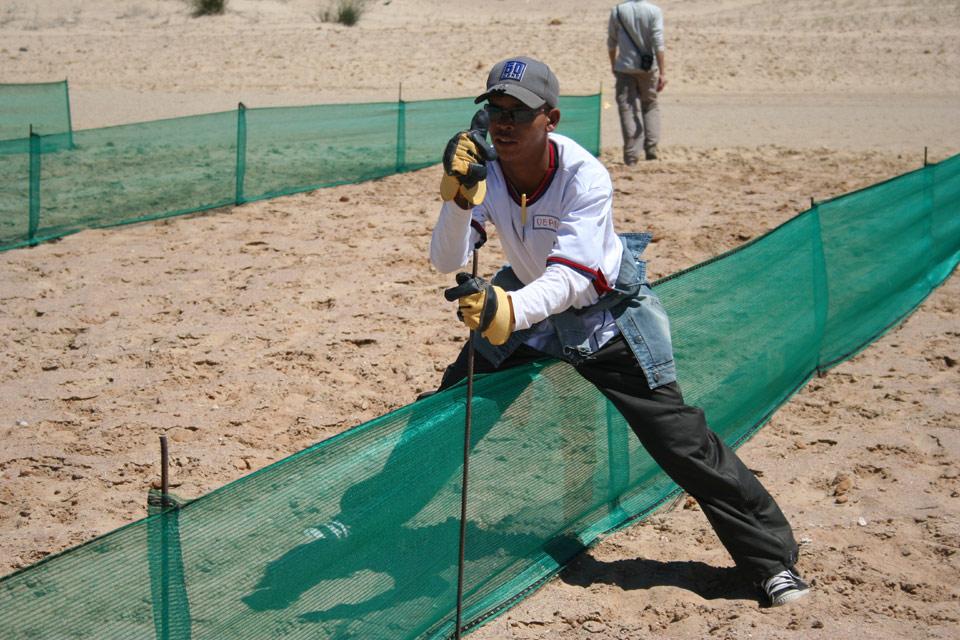This NRI model has resulted in the integration of restoration into mining business practices, and generated both jobs and future livelihood opportunities for the communities living in mining areas.
Training to provide a pool of restoration skills
A practical training programme based on the results of research by the NRI was developed and has so far been run three times for the potential business owners and workers. The five day intensive training course is held at a location near the mining operation involved, is aimed at unemployed members of the communities, and is only run if the mining operation has committed to developing (through NRI mentorship) a restoration business at the end of the course. The training is both theoretical (indoors) and practical (on-site, outdoors), and covers aspects of Namaqualand ecology that is relevant to restoration activities on the West Coast of South Africa.
As the restoration methods are based on ecological understanding, the aim is to give trainees enough background knowledge to empower them to make more accurate decisions on the ground. The topics covered include: Namaqualand’s climate, vegetation types, plant functional groups, the reproductive biology of Namaqualand’s plants, and ecological processes such as patch dynamics and succession. The training also covers the mining process, as it is important to understand the operational setup of the mines, as well as the surrounding landscape. The majority of the training focuses on four restoration activities (netting; seed collection, storage & preparation; restoration packs; and transplants), giving a detailed theoretical background into each activity, as well as practical demonstrations and hands-on training for each trainee. This knowledge is tested at the end of the training course to ensure an understanding of all activities, since they are all required for achieving restoration goals.
Restoration business establishment and mentorship
The first business was started in 2007 after a rigorous selection and development process of owner-managers. Other restoration contracting businesses have since been developed in the region and these businesses compete productively with each other, but the original business managed to maintain continuous contracts to support the full complement of workers until the sale of the mine in 2013.
In addition to the training that is provided to both the owner-managers and workers in the restoration businesses, the NRI continues to provide on-site guidance and mentorship to these young businesses, particularly in the technical and scientific aspects e.g. production of restoration packs.
At the start of each restoration season the NRI scientifically plans the implementation of ecological restoration, and after providing the exact specifications for each site (density, species mix, number of seeds and transplants of each species, type or restoration pack, soil ameliorants etc.) spends time in discussion with both the mine (client) and restoration business (contractor), to ensure thorough understanding and cooperation between all three parties.

Part of the NRI specifications for the ecological restoration of one site on a diamond mining operation in Namaqualand
Developing an economy for restoration
Perhaps most importantly, the NRI developed a payment system for restoration contracts that incorporates the numerous steps involved in their system of ecological restoration into four payment activities. Through their adoption of this system, the mining companies offer contracts that provide year-round employment and a year-round revenue stream to contracting restoration businesses. Often restoration activities are dictated by seasonality and restoration workers have to find employment in another sector for a portion of the year, making real skills and career development difficult. The NRI innovations of developing and grouping activities across an annual work-plan overcame a significant challenge for restoration businesses and facilitated the development of the sector as a whole.
The restoration approach was developed to fit into the mining operation and the mining business, for example, simple but thorough method sheets for restoration contractors to follow have been drawn up for each restoration activity, and these are easily converted into the “scope of work” documents in use (and legally compliant) on the mines.
Integrating supporting systems for restoration
Various supporting sytems have been developed to provide assurance to the mines that their restoration contracts are being properly implemented. Monitoring and assurance systems guarantees the mine is getting what it pays for without having to develop or employ its own technical specialists, while simultaneously providing valuable technical understanding to the NRI of the ecological success under the specific conditions at each site. This ongoing monitoring of restoration is funded by the client (usually a mining operation) within the payment models for restoration implementation. The results of this monitoring are used to further improve understanding and implementation systems, and are also being used to plan and implement more environmentally efficient mining operations in the region.
An important secondary employment and wealth generation benefit has been created by the NRI restoration methods (e.g. part-time seed collection employment for individuals) and logistical support by surrounding businesses (e.g. providing hundreds of thousands specially designed restoration pack boxes).
The NRI has proven that proper restoration is possible, cost-effective, can be integrated into the mining process, and generates job and enterprise development opportunities.



